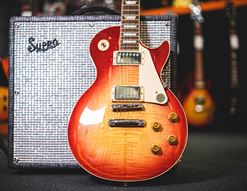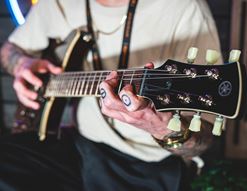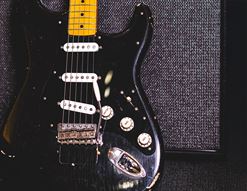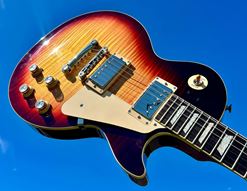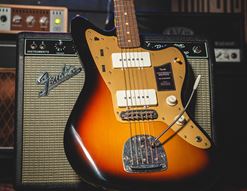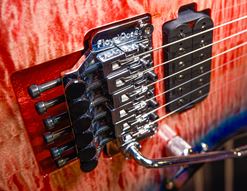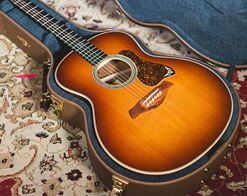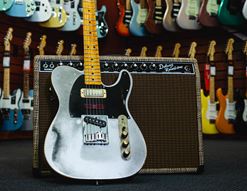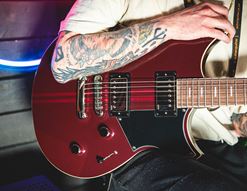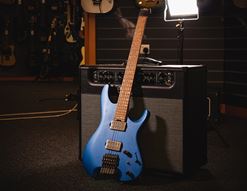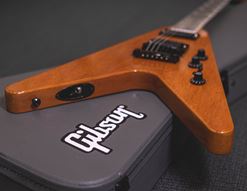Do you think of the Stratocaster as a ‘riff’ guitar? It’s the most famous electric guitar of them all, but not everybody immediately associates them with riffs. That may be because their slinky, skinny sound is well suited to rhythmic funk but less obviously adept at chunking low end notes.
Still, who says that’s how riffs have to be? Riffs can be all sorts of things, and today I’m going to prove just how riff-worthy the Fender Stratocaster is! I’ve picked out ten examples from rock history, from the black and white days to now, all of which utilise the Strat in a rifftastic way!
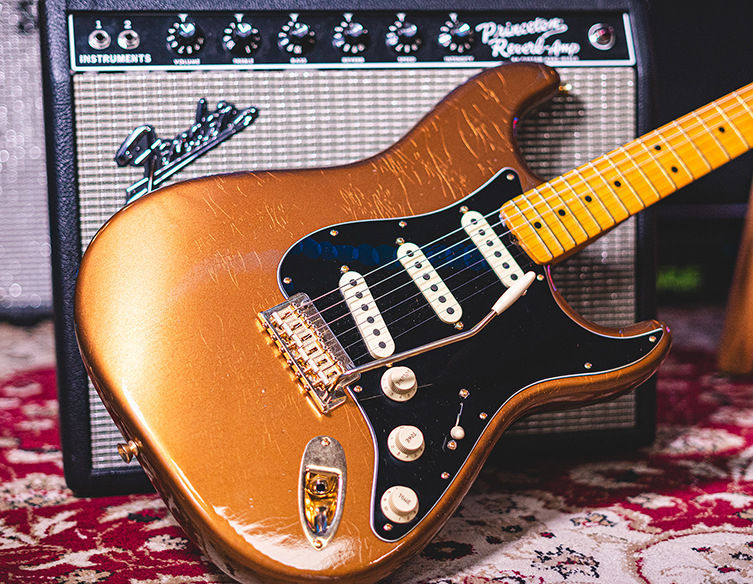
Apache - The Shadows
Hank Marvin is the original Strat hero. His red/pink Strat was allegedly the first in the UK, thanks to his then-boss and bandleader Cliff Richard buying it for him. That guitar, together with lots of reverb and echo, helped Hank create his melodic and beautifully haunted guitar tone. Truly, people get obsessed by the minutiae of Marvin’s equipment, when of course the main ingredient here is the man’s musicality and knack for a tune!
Hank Marvin Guitar Gear
- 1959 Fiesta Red Stratocaster (often referred to as Flamingo Pink) with gold hardware
- Vox AC30
- Meazzi Tape Echo or a Binson Echorec (sources disagree)
Miserlou - Dick Dale
Miserlou is one of the tunes that you can never quite play properly. I don’t know what it is (volume, picking hand pressure, humongous strings…) but every time somebody plays this awesome tune, it comes off weak compared to Dick Dale’s original.
It doesn’t stop us trying though, and whether you first heard it in Pulp Fiction or back in the day, we all know it’s one of the all-time great Strat riffs.
Dick Dale Guitar Gear
- Fender ‘The Beast’ Stratocaster, modded for no tone controls, master volume and a toggle for neck and middle only.
- String gauges: .016, .018, .020 (all unwound), .039, .049, .060 (wound)
- Heavy picks
- Fender Dual Showman amplifier (developed by Dick with Leo Fender)
- Fender Spring Reverb tank
- Monstrous volume
Purple Haze - Jimi Hendrix
Is Purple Haze Hendrix’s best riff? It’s certainly up there, and is relatively restrained compared to some of his other fretboard excursions. Hendrix is obviously the ultimate Strat player, and this riff displays his talent for seeing fresh potential in otherwise well-used fretboard patterns.
This might be heresy, but I sometimes feel like the studio recording seems a little stiff and lurching, especially when compared to the fluidity of live versions. Either way, it’s a belter of a Strat riff!
Now, before anybody calls me out: I know the solos were played on a Telecaster, okay? Picture Jimi playing a Tele! It’s not right in my mind. Anyway, the immortal riff is a Strat so full steam ahead here!
Jimi Hendrix Purple Haze Guitar Gear
- Fender Stratocaster (he used many, but his main one was arguably a 1968 Olympic White model)
- Arbiter Fuzz Face
- Roger Mayer Octavia
- Marshall Plexi Head and Cab (studio version used a Fender Bassman)
- Fender medium celluloid picks
- 10-48 strings
Smoke on the Water - Deep Purple
Smoke on the Water’s signature riff is arguably the most-played one in existence, so it definitely belongs here! Ritchie Blackmore’s immortal phrase is as simple and iconic as it gets. It’s amongst the first riffs that most of us get under our fingers, but that hasn’t diluted it’s raw rock power.
The tune was inspired by a real event, too: a fire during a Frank Zappa concert in Montreux, which the Deep Purple chaps witnessed happening from across the Danube.
Blackmore is of course a Strat guy, and here’s what else he used to get that tone happening…
Ritchie Blackmore Smoke on the Water Guitar Gear
- Fender 1970 Stratocaster (with modified ‘scalloped’ fingerboard)
- Marshall Major Head (modified, I believe, for earlier breakup)
- JHS (John Hornby Skewes) Treble Boost Pedal
- Gauge 10-42 strings
Sails of Charon - The Scorpions
This fantastic hard rock stomp has an absolutely epic guitar solo by Uli Jon Roth, but the song contains at least two fantastic riffs too. Whilst fellow guitarist Michael Schenker favoured the Gibson Flying V, Roth was a dedicated Strat player, which he took to its limits and then left behind for his own-design Sky guitars.
I had the pleasure of chatting with Uli a year or so ago, and this song was included in the conversation. Check out the guitarguitar Uli Jon Roth interview, and have a glance below at this list of his 1970s-era gear, which he used for the riffs and solo to Sails of Charon.
Uli Jon Roth Sails of Charon Guitar Gear
- Fender Stratocaster Olympic White
- Marshall 100w Super Lead or Super Tremolo head (reports differ), early 70s models
- Marshall 4x12 cabinets with high wattage Celestion speakers (sources indicate 65, 70 and even 80 watt speakers!)
- Crybaby Wah
- Fuzz Face (live only, the studio recording is purely the amplifier)
Number of the Beast - Iron Maiden
Iron Maiden have always been a band of Strat players. Nowadays, all three lead guitarists - Dave Murray, Adrian Smith and Janick Gers - have modified Strats or Strat types (Adrian likes a Jackson S-type), and in fact Dave Murray’s main guitar is the same one he used back in 1982 for the band’s seminal Number of the Beast album!
Iron Maiden have more great riffs than you can shake a stick at. Instead of being clever, I chose to go with one of their best-known. Number of the Beast’s title track is an instant classic, an early trademark of the band’s sound.
Whilst Adrian Smith was partial to an Ibanez Destroyer at this time - and why not? - Murray was using his famous 57 Strat, modified with humbuckers. This means that the riff doesn’t really sound like a Strat if I’m being honest, but it technically is played on one, and a tasty vintage one at that, so I’m sticking it on the list!
Dave Murray Number of the Beast Guitar Gear
- Fender 1957 Stratocaster, modified with two DiMarzio humbuckers: a Super Distortion (bridge) and PAF (neck).
- Fender 10-46 gauge strings
- Dunlop celluloid picks
- Marshall JCM800 2203 head
- Marshall 1960 cabinet
- BOSS SD-1 Super Overdrive
- MXR Phase 90
Sultans of Swing - Dire Straits
This smooth riff on Sultans doesn’t show up straight away: there’s a bunch of lovely, tasteful licks to enjoy before Mark Knopfler gives us this iconic piece of Strat-glory. The whole tune is a masterclass in guitar work, with Mark’s clean, fingerpicked tone fitting the vibe perfectly.
Mark Knopfler Sultans of Swing Guitar Gear
- Fender 1961 Stratocaster, refinished in Hot Rod Red (originally Natural), middle pickup selected
- Fender 1961 Vibrolux amp
- Mark’s fingers
Can’t Stop - Red Hot Chili Peppers
John Frusciante is definitely a guitar hero for the modern era. Accessible, with a little bit of flash, he’s the perfect foil for bandmate Flea’s superlative bass playing.
The Chili Peppers’ brand of funk doesn’t actually overtly rely on riffs, but Can’t Stop is a winning example of the exception. After a large build up, youtube a fantastic ‘guitar moment’ that is as unmistakable as it is enjoyable. And it’s a Strat tone through and through, with Frusciante’s signature attack and directness.
John Frusciante Can’t Stop Guitar Gear
- Fender 1962 Stratocaster
- Marshall Major 200-watt head
- Marshall Super Bass 100-watt head
- Dunlop Tortex 0.60mm picks
- BOSS DS-2 Turbo Distortion
That Golden Rule - Biffy Clyro
Is this one of Biffy’s finest moments? Simon Neil is a committed Strat user, and That Golden Rule is filled with fuzzed-out riffs that mix grunge with punk to great effect. There’s also a great orchestral part at the end of the song, with even more caustic Strat riffing, but I’ll take the intro’s intensity first!
Simon Neill The Golden Rule Guitar Gear
- Fender Custom Shop 1963 Stratocaster
- Fender Texas Special pickups
- Marshall 1959 Plexi head
- Fender Hot Rod Deville 212 combo
- BOSS DS-1 Distortion
- BOSS MT-2 Metal Zone
- Dunlop nylon 1mm pick
Fluorescent Adolescent - Arctic Monkeys
This early-ish cut from the band’s second album displays some tasty guitar back and forth. During this time, frontman Alex Turner was primarily playing a white Strat, and a humble Mexican Standard model at that! His tone was all about clarity and timing, and the cut and twang of a Strat is absolutely the correct guitar for the job!
Alex Turner Fluorescent Adolescent Guitar Gear
- Fender Standard Stratocaster Olympic White
- Vox AC30
- Ibanez TS-808 Tube Screamer
A Strat For All Seasons
There you have it: ten examples of popular and famous Stratocaster riffs from 1960 till…not long ago! Throughout the history of rock music, the Strat has occupied a central role and that’s regardless of the musical style being played. My list today has pop, psychedelic rock, metal, soft rock, and even surf music! If nothing else, it proves how undeniably versatile the Strat is, but that’s hardly news to you, right? Everyone who picks up a Strat plays it in their own way, as you can tell from the artists above. Considering how distinctive the Strat sounds, that’s an impressive feat!
I’m sure you’ve played many Strats, but if it’s been a while, then maybe it's time to see what happens when you choose a Strat!
Click to View our Fender Stratocasters




